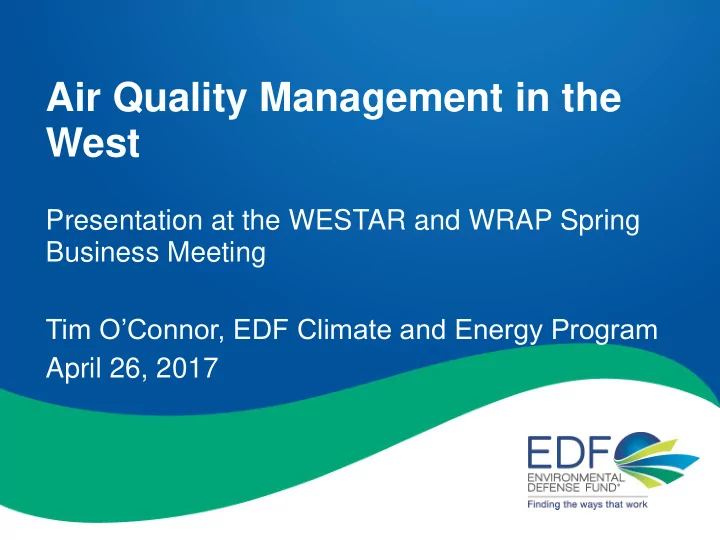

Air Quality Management in the West Presentation at the WESTAR and WRAP Spring Business Meeting Tim O’Connor, EDF Climate and Energy Program April 26, 2017
Organization of discussion • Air Quality Concerns • Existing regulatory frameworks • Emerging regulations and legislation • Questions for consideration going forward
Air Quality Concerns State of the Air Report – Worst US Areas Ozone Particle Pollution Short-Term Particles #1: Los Angeles-Long #1: Visalia-Porterville- #1: Bakersfield, CA Beach, CA Hanford, CA #2: Fresno-Madera, CA #2: Bakersfield, CA #2: Bakersfield, CA #2: Visalia-Porterville- #3: Fresno-Madera, CA #3: Fresno-Madera, CA Hanford, CA #4: Visalia-Porterville- #4: San Jose-San #4: Modesto-Merced, Hanford, CA Francisco-Oakland, CA CA #5: Phoenix-Mesa- #5: Los Angeles-Long #6: San Jose-San Scottsdale, AZ Beach, CA Francisco-Oakland, CA #6: Modesto-Merced, #6: Modesto-Merced, #7: Salt Lake City- CA CA Provo-Orem, UT #7: San Diego- #7: El Centro, CA #9: Los Angeles-Long Carlsbad, CA #10: San Luis Obispo- Beach, CA #8: Sacramento- Paso Robles-Arroyo #10: Reno-Carson City- Roseville, CA Grande, CA Fernley, NV #10: Las Vegas- Henderson, NV-AZ
The quality of environment is still harming California families – a lot of work to do • Most counties in California are in non-attainment for 8-hour ozone standard • Similar results for PM 10 standard • More counties in attainment with PM 2.5 standard
Air Quality Concerns • Nearly 4 in 10 people (38.9 percent) in the United States live in counties that have unhealthful levels of either ozone or particle pollution…More than 125 million Americans in 204 counties But, its not just criteria pollutants that need to be addressed… …Toxic air contaminants …Greenhouse Gases - 3236 facilities in CARB emissions search tool - 812 facilities in the CARB GHG reporting program - Non-point source transportation remains largest
Emissions sources in CA Contribution of GHG by facility Air Toxics by facility transportation # 1: Tesoro Refinery # 1: Hixson Metal Largest contributor to # 2: Chevron Refinery # 2: Bowman Plating smog-forming and diesel # 3: Shell Refinery # 3: Gerdau PM emissions # 4: Chevron Refinery # 4: Pacific Ship Rep. • # 5: Aera Energy # 5: SD Metro Pumping 80 % of NOx • # 6: Chevron Oil Prod. # 6: Pacific Steel 50 % of GHGs • # 7: Valero Refinery # 7: Ellwood Onshore 90 % of toxic diesel # 8: Mountainview Power # 8: Phillips 66 Refinery PM # 9: Nat’l Steel and Ship # 9: Berry Pet. Oil Prod. # 10: La Paloma Power # 10: OC Waste & Rec. Plant
Existing regulatory frameworks • Local pollution / point source req’s – Local Air Quality regulatory requirements, implementation of federal permitting and federal source standards – AB 2588 hot spots program (1987) and HRA’s • Climate – AB 32 (targets and scoping plan), SB 32 / AB 197 – SB 375 Regional GHG targets – SB 1383 and SLCPs (methane and PM especially) – Advanced clean cars
Existing regulatory frameworks • Clean Energy – SB 350 implementation and Integrated resource planning – Energy agency efficiency standards – Energy agency research, planning and siting • Vehicles and transportation – Integrated action plans of state and local actions – 2016 mobile source strat. as included within SIP
Implementation of the Mobile Source Strategy - Integrated Truck Strategy - Incentives, Introduce ZEVs, demos and pilots ensure engines remain clean, establish cleaner engine standards - Innovative clean transit - Passenger vehicles - Advanced clean cars 2.0 / 2026 and beyond standards - Low Carbon Fuel Development - Regional plan integration - SCAQMD - AQMP
Emerging regulations and legislation • New and improved pollution reduction programs for local sources – Re-examined ports and good movements – CARB 2017 scoping plan – BAAQMD “Spare the Air, Cool the Earth” plan – SCAQMD move beyond RECLAIM within the 2016 AQMD – Enhanced EV deployment initiatives (VW settlement, AQMP) • Climate and clean energy – Extending cap-and-trade – Expansion of energy imbalance market and the energy grids – Integration of electric and natural gas markets – New resource adequacy requirements for utilities
The BIG questions… • Whether the agencies, who have laid out ambitious plans for GHG and local pollution reduction, will actually achieve the level of ambition many want – Transportation – Ports – Agriculture – Clean energy – Stationary sources (refineries) • What new legislative requirements will be enacted – Cap-and-trade extension – 100% renewables – Regional energy markets
The BIG questions… • Whether energy agencies are willing to make a few fundamental changes to the way things work – Cost-benefit analysis at the CPUC related to using societal cost tests vs. total resource cost tests – Use of the social cost of carbon and methane – Siting requirements at the CEC – Gas and electric market instruments at CAISO • How the federal government interacts with the states
Timothy O’Connor Email: toconnor@edf.org Phone: (916) 549 – 8423
Recommend
More recommend